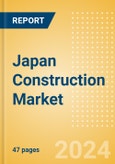The Construction in Japan - Key Trends and Opportunities to 2029 (H1 2025) report provides detailed market analysis, information and insights into the Japanese construction industry, including:
- The Japanese construction industry's growth prospects by market, project type and construction activity
- Critical insight into the impact of industry trends and issues, as well as an analysis of key risks and opportunities in the Japanese construction industry
- Analysis of the mega-project pipeline, focusing on development stages and participants, in addition to listings of major projects in the pipeline.
Over the remainder of the forecast period, the construction industry’s output is expected to record an annual average growth rate of 1.2% between 2025 and 2029, supported by investments in the renewable energy, commercial, and industrial sectors in line with the government’s aim to boost the country’s semiconductor industry. For instance, in November 2024, the government announced an aid of JPY9.1 trillion ($65 billion) for boosting the country’s semiconductor and artificial intelligence infrastructure through subsidiaries and financial incentives by 2030. Also, in December 2024, the government announced an investment of JPY300 billion ($2.1 billion) to support the research, development, and production of the semiconductor industry, including JPY100 billion ($712 million) for the construction of local chipmaker, Rapidus, nanometer chips facility in Hokkaidoof by 2027. Growth will also be supported by the government’s target of all new cars to be sold to be electric by 2035. To support this, in September 2024, the government announced its plan to allocate JPY1 trillion ($7.1 billion) as subsidiaries to support the development of electric vehicle batteries in the country by 2028. Among the recent developments, local automotive company, Mazda, in early January 2025, announced its plan to construct a 10GWh battery production plant in Iwakuni by 2030. Also, in early January 2025, local automaker, Nissan, announced its plan to construct a JPY153.3 billion ($1.1 billion) 5GWh battery production plant in Fukuoka, spanning 150,000m2 by 2028. Over the long term, the industry’s growth will be supported by the government’s plan to invest JPY25.7 trillion ($200 billion) in the construction of high-speed rail lines, the doubling of existing tracks, the electrification of routes, and the upgradation of freight terminals between 2020 and 2030.
Scope
This report provides a comprehensive analysis of the construction industry in Japan. It provides:
- Historical (2020-2024) and forecast (2025-2029) valuations of the construction industry in Japan, featuring details of key growth drivers.
- Segmentation by sector (commercial, industrial, infrastructure, energy and utilities, institutional and residential) and by sub-sector
- Analysis of the mega-project pipeline, including breakdowns by development stage across all sectors, and projected spending on projects in the existing pipeline.
- Listings of major projects, in addition to details of leading contractors and consultants
Reasons to Buy
- Identify and evaluate market opportunities using our standardized valuation and forecasting methodologies
- Assess market growth potential at a micro-level with over 600 time-series data forecasts
- Understand the latest industry and market trends
- Formulate and validate business strategies using the analyst's critical and actionable insight
- Assess business risks, including cost, regulatory and competitive pressures
- Evaluate competitive risk and success factors
Table of Contents
1 Executive Summary2 Construction Industry: At-a-Glance6 Construction Market Data
3 Context
4 Construction Outlook
5 Key Industry Participants
7 Appendix
List of Tables
List of Figures








